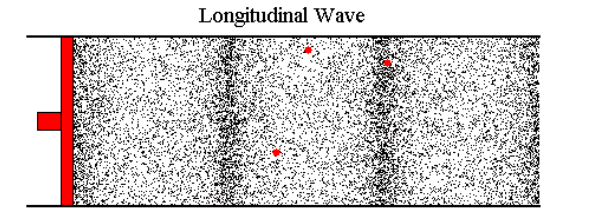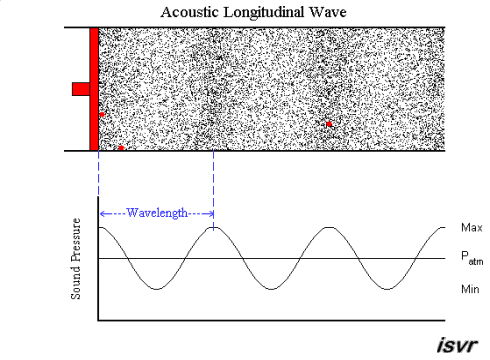A Ruben's tube is a closed tube with many holes drilled into it. It has a diaphragm at the end of the tube, so that sound waves from an external source can easily enter the tube.
It can be used to demonstrate the effects of soundwaves visually, such as standing waves or pressure differences in speakers through music. All music and sound is made up of waves. These waves make particles oscillate back and forth quickly, which vibrate your eardrum and allows your brain to sense sound.
The speaker in this case would be the red piston. Anything that oscillates (moves back and forth) is capable of producing a sound wave. The darker areas that move to the right are called compressions, where particles are pushed closer together. The lighter parts in between are rarefactions, where there is a lack of particles, as they have migrated to the compressions. The pressure of the wave changes as it passes a point - the red dots experience high pressure at the compressions, and then low pressure at the rarefactions. If the pressure was modelled as a wave, it would like look this:
The pressure that passes a point will fluctuate due to the speaker disturbing the air.
If these waves are sent down a tube, they will bounce of the end and form what's known as a standing wave.
Of course, the waves do not just pass each other like shown above- they add up and interact with each other. We can draw another wave that shows the sum of the 2 waves moving in opposite directions, and we get a still wave that oscillates but doesn't move.

A more detailed diagram of this Rubens tube is shown below:
This is simply a diagram showing how the gas is injected and where the materials are from. The sound chamber is added so that the Ruben's tube can work with larger speakers, so that the difference is amplified and larger peaks and smaller troughs are made.
The hole from this PVC was then 'copied' over to the main flame tube, with an identical hole where the two fit snugly together, forming a seal.
The check valve that was used to create the threads in the PVC can then be screwed in. More Teflon tape is used as the threads may wear over time, allowing the gas in the tube to escape through the threads. Having Teflon tape prevents this from happening.
Once one side of the check valve is screwed in, the other threaded side can be used to connect the whole assembly to a gas source.
Once one side of the check valve is screwed in, the other threaded side can be used to connect the whole assembly to a gas source.
The end of the gas hose is then screwed into the valve to make an airtight and gas tight fit, allowing the flow of fuel to easily be regulated with the red valve.
Some planks of wood can then be cut to size, with notches being made by drilling large holes in a sections of wood, and then cutting them down the middle to create semi circular channels to hold the Ruben's tube securely.























